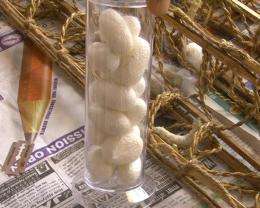May 3, 2012 weblog
Silkworm structures drive push for new materials

(Phys.org) -- Research published in the peer-review Journal of the Royal Society Interface on Wednesday presents a close look at the structure and physical properties of silkworm cocoons. The paper’s research efforts could move scientists closer toward coming up with tomorrow’s design principles for materials inspired by silkworm cocoons. Those materials might provide important advancements in materials for such areas as defense and manufacturing. The authors, Fujia Chen, David Porter, and Fritz Vollrath, note that silkworm cocoons have an impressive range of optimal structures. These are lightweight, strong and porous, and ideal for the development of “bio-inspired” composite materials.
The authors examine cocoon structure. Specifically, they present observations and measurements on twenty-five diverse types of cocoons. They set out to correlate their physical properties with the cocoons’ structure and morphology.
Some advanced materials that could benefit from that understanding might end up in the manufacture of car panels, helmets and protective suits for mine workers. The study’s research was funded by a grant from the U.S. Air Force.
Their work is certainly not the first nor the last that will talk about nature’s silk producers and what scientists can learn. Spider silk is recognized as an intriguing material in that it is strong and tough and elastic enough to stretch several times its original length.
Earlier this year, Discover issued a report on lab work at the University of Wyoming, where silk-spinning silkworms were genetically engineered to spin a hybrid material, partly their own silk and partly that of a spider. Also earlier this year, scientists from Germany’s Max Planck Institute for Heart and Lung Research created artificial heart tissue from silk produced by silkworms.
Earlier this week, The Engineer reported that scientists from Tufts University in the U.S. bonded silk protein microfibers from silkworm cocoons to a silk protein scaffold to create a material that mimics the stiffness and surface roughness of bone.
As for the publication on Wednesday, Prof. David Porter for the last few years has been collaborating with spider expert Fritz Vollrath at Oxford to study polymer science models and spider silk.
They are part of The Oxford Silk Group, in the Department of Zoology, at Oxford. In studying the biology of spider silks, they hope to unravel the chemistry and evolution of these materials, along with a focus on spider-web engineering and behavior.
As produced by spiders and insects, natural silks are made under benign conditions--- ambient temperature, low pressure, and with water as solvent. “Clearly,” according to a statement from the Oxford Silk Group, “this is something we should aim to copy when designing and making fibers for the future.”
Journal information: Journal of the Royal Society Interface
© 2012 Phys.Org




















